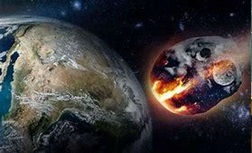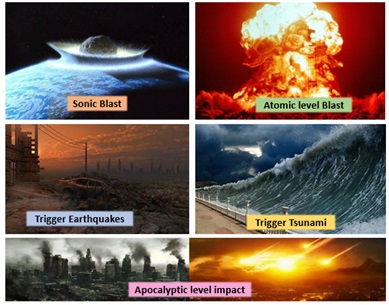ARE WE PREPARED?
AN INSIGHT INTO OUR PLANETARY DEFENSE SYSTEM
By Eng. (Mrs) Nimali T. Medagedara We find solace in believing that we are the only intelligent beings in our solar system. This is a topic that has been widely debated over the years, by scientists, mathematicians, and religious clans alike. Even though an attack from an intelligent species, yet remains highly unlikely, we cannot overrule a mass extinction scale visitor; an asteroid!!
Ancient stargazers, quite oblivious to this impact, have starred with wanderlust to follow these glowing trails of light in the shape of shooting stars, through centuries, spinning folk tales, myths, curses and what not. However, these “shooting stars” aka “asteroids”, may not always be the charming night to dusk visitors, they seem to be.
We find solace in believing that we are the only intelligent beings in our solar system. This is a topic that has been widely debated over the years, by scientists, mathematicians, and religious clans alike. Even though an attack from an intelligent species, yet remains highly unlikely, we cannot overrule a mass extinction scale visitor; an asteroid!!
Ancient stargazers, quite oblivious to this impact, have starred with wanderlust to follow these glowing trails of light in the shape of shooting stars, through centuries, spinning folk tales, myths, curses and what not. However, these “shooting stars” aka “asteroids”, may not always be the charming night to dusk visitors, they seem to be.
If we go back a few years to 2013, one such asteroid( a meteorite) streaked over Russia and exploded in the sky above Chelyabinsk, shattering windows and injuring nearly 1200 people, as it entered our atmosphere releasing a power much close to that of an atomic bomb. A far smaller one in 1908 leveled 80 million trees with a force thousand times more powerful than that of an atomic bomb in Tunguska, Siberia. Even though some may argue that these could be one-time events, if we go back much further, decades, centuries back, to approximately 66 million years ago, one such asteroid doomed the dinosaurs that once roamed the Earth to extinction. The crater created from this impact (Chicxulub), still lies 200 Km (125 miles) in Mexico.
All this information leaves us wondering, "what exactly is an “Asteroid”? what are the chances of such an asteroid to impact Earth? what would happen in the case of such an impact? on what conditions would an asteroid be entering Earth to cause massive damage? and how close are we to such an event of mass scale extinction? How well are we prepared to welcome an unsolicited visitor as such? ". So, buckle up for a ride through the starry night as we find answers to these questions!
 To begin with, an “asteroid” is a planetary body orbiting around the sun and is believed to be leftover from the formation of our solar system. Even though we use the jargon “asteroid”, no two asteroids look the same. They vary greatly in shape and size, from almost 1000 km to just a meter across. A Majority of Asteroids are made from rocks, clay, and metals such as Nickel and Iron. Since asteroids had formed at the beginning of our solar system, they are believed to be treasure troughs of information about the history of planets and the sun. Therefore, several NASA missions have been dedicated to studying asteroids including the NEAR Shoemaker SpaceCraft landing on Eros (an asteroid near earth) in 2001, the Dawn Spacecraft that orbited Vesta (an asteroid in the asteroid belt) in 2011 and Ceres from 2012 onwards. Recent explorations include the OSIRIS-Rex Spacecraft’s launch to study Bennu (near-earth) from 2016 onwards. Now what concerns us specifically, is the location of these asteroids. Based on this, asteroids are classified as those in the Asteroid Belt, Trojans, and Near-Earth asteroids.
To begin with, an “asteroid” is a planetary body orbiting around the sun and is believed to be leftover from the formation of our solar system. Even though we use the jargon “asteroid”, no two asteroids look the same. They vary greatly in shape and size, from almost 1000 km to just a meter across. A Majority of Asteroids are made from rocks, clay, and metals such as Nickel and Iron. Since asteroids had formed at the beginning of our solar system, they are believed to be treasure troughs of information about the history of planets and the sun. Therefore, several NASA missions have been dedicated to studying asteroids including the NEAR Shoemaker SpaceCraft landing on Eros (an asteroid near earth) in 2001, the Dawn Spacecraft that orbited Vesta (an asteroid in the asteroid belt) in 2011 and Ceres from 2012 onwards. Recent explorations include the OSIRIS-Rex Spacecraft’s launch to study Bennu (near-earth) from 2016 onwards. Now what concerns us specifically, is the location of these asteroids. Based on this, asteroids are classified as those in the Asteroid Belt, Trojans, and Near-Earth asteroids.
The location of the asteroids and the distance they are from Earth matters when calculating the risk of a possible impact. A near-Earth object (NEO) is an asteroid or comet whose orbit brings it into or through a zone between approximately 195 million kilometers from the Sun, meaning that it can pass within about 50 million kilometers of Earth’s orbit.
- What are the chances for such an asteroid to impact the Earth?
Not every meteorite shower brings about an apocalyptic event! For an object to enter through the atmosphere without burning up, it should be at least around 40 meters in width. According to NASA estimates, more than 300,000 objects larger than 40 meters (131 feet) wide orbit the sun as NEO (Near Earth Objects), with many being difficult to detect more than a few days in advance. With that being said, it is important to observe that the asteroid that disintegrated above Russia, was merely 20 meters wide. However, the resultant shock wave injured thousands due to the shattering of glass. Several hundreds of smaller asteroids disintegrate harmlessly each day close to the planet. Small asteroids a few meters in size have been detected passing between Earth and the Moon’s orbit several times a month. “Meteoroids” are very small fragments of asteroids that enter the Earth’s atmosphere and explode virtually every day, causing the bright meteor events that we see at night. Therefore, it is very much important that we are well prepared to identify those that would cause calamity and take necessary corrective actions to prevent the trajectory path leading to an Earth impact.
- What would be the result of such an impact?
 Now I am sure that we all agree that an asteroid impact may cause serious consequences for Earth’s inhabitants and their future, depending on the size of the asteroid, and the location of impact.
Now I am sure that we all agree that an asteroid impact may cause serious consequences for Earth’s inhabitants and their future, depending on the size of the asteroid, and the location of impact.
We would only get to see the asteroid from the naked eye, most probably only 24 hours or so from impact. When an asteroid more than 40 meters wide enters the atmosphere, it may impact Earth with a force of 100 trillion tons of TNT! And as a result, the earth’s crust would be entirely vaporized and anything within a 1200km radius will be burnt instantly. This would most probably be followed by a sonic blast that would flatten everything within a 1000km radius of the epicenter triggering massive earthquakes and tsunamis.
- So, what are our options?
Now that you know what we will be facing, I am sure you all are wondering whether we go on board Doomsday or already have any strategies to face this. "Will we have enough time to build bunkers to protect all of Earth’s citizens, relocate every last man on Earth to a location safe from the epicenter? Can we spare our Earth from annihilation from stopping this asteroid from ever entering our Earth’s atmosphere?"
The Sentry Impact Risk Table, which is maintained by the Jet Propulsion Laboratory’s Center for NEO Studies, is updated continuously as new asteroids are discovered and known asteroids are further observed.
So far NASA has devised three strategies with each method’s effectiveness determined by the size and composition of an asteroid and the risk of level it poses.
1.) Kinetic impact - This strategy relies on directly hitting the asteroid with a spacecraft, to change its path of trajectory. A very small alteration could suffice, if the asteroid still has millions of miles to cover before striking Earth.
2.) Gravitational Approach – Implementing a “Gravity Tractor”, where a spacecraft would be attached or hinged to the asteroid, which would alter its orbital path, due to the enlarged mass.
3.) Nuclear Explosion – A nuclear explosion on a massive asteroid would superheat the surface and cause some of the mass to break off. A spacecraft could then nudge the asteroid off its path of trajectory.
NASA will be completing its Double Asteroid Redirection Test (DART) mission in 2021-2022, where they will impact the moon of a binary asteroid “Didymos”, to perform experiments on altering the course of an asteroid.
- Any “near misses” and any future strikes in our life-time?
One of the most recent near misses happened on 13th of Friday, this November, an asteroid named 2020 VT4, which was spotted only 15 hours later by the Asteroid Terrestrial-impact Last Alert System survey at the Mauna Loa Observatory in Hawaii. This passed by our planet under merely 400Km (the same distance that the International Space Station orbits the Earth). With the year 2020 having all of its calamities, the record for the closest ever fly by was also recorded this year, at an altitude of just 1830 miles over the South Indian Ocean.
Close fly by events are predicted as follows for this century.

However, NASA itself says that,“No known asteroid poses a significant risk of impact with Earth over the next 100 years. The highest risk of impact for a known asteroid is a 1 in 714 chance of impact by an asteroid designated 2009 FD in 2185, meaning that the possibility that it could impact then is less than 0.2 percent.” One asteroid that NASA is studying up close, as we read earlier, Bennu, has a 1/2700 chance of impacting Earth between 2175 and 2195.
Therefore, though we cannot completely overrule an extinction level event for this century, it is safe to say that we are prepared globally for such an encounter. However, Sri Lanka as an island in the Indian Ocean, would be inevitably submerged from Tsunamis, in the place of such an event. Our Sri Lankan resources, and disaster management procedures still have a long way to go in terms of being equipped for this. Nevertheless, knowledge is being renewed day by day, and for this century, we are hopefully safe for now, from this unsolicited visitor!!
- Resources
- Asteroid skimmed past Earth on Friday 13th but wasn’t spotted until next day (msn.com)
- Why Can't We Prevent An Asteroid Strike? | NOVA | PBS
- About 1,100 injured as meteorite hits Russia with force of atomic bomb | Fox News
- Asteroid that wiped out the dinosaurs hit at 'deadliest possible' angle - CNN
- How NASA plans to prevent an asteroid apocalypse (mybroadband.co.za)
- Did You Know... | NASA
- What Would Happen in the Aftermath of an Asteroid Impact? | SD Entertainer Magazine
- This is not a drill: NASA sacrificing spacecraft to knock asteroid off course (thenewdaily.com.au)
- How to engage the reader in the opening paragraph - BBC Bitesize
- List of asteroid close approaches to Earth - Wikipedia
 Eng. (Mrs) Nimali Tennekoon Medagedara
Eng. (Mrs) Nimali Tennekoon Medagedara
BSc Eng (Hons) (Peradeniya), MPhil (SHU),
MIE (SL), C.Eng., MIEEE, Member of SLAAS
Senior Lecturer, Department of Mechanical Engineering
The Open University of Sri Lanka.





